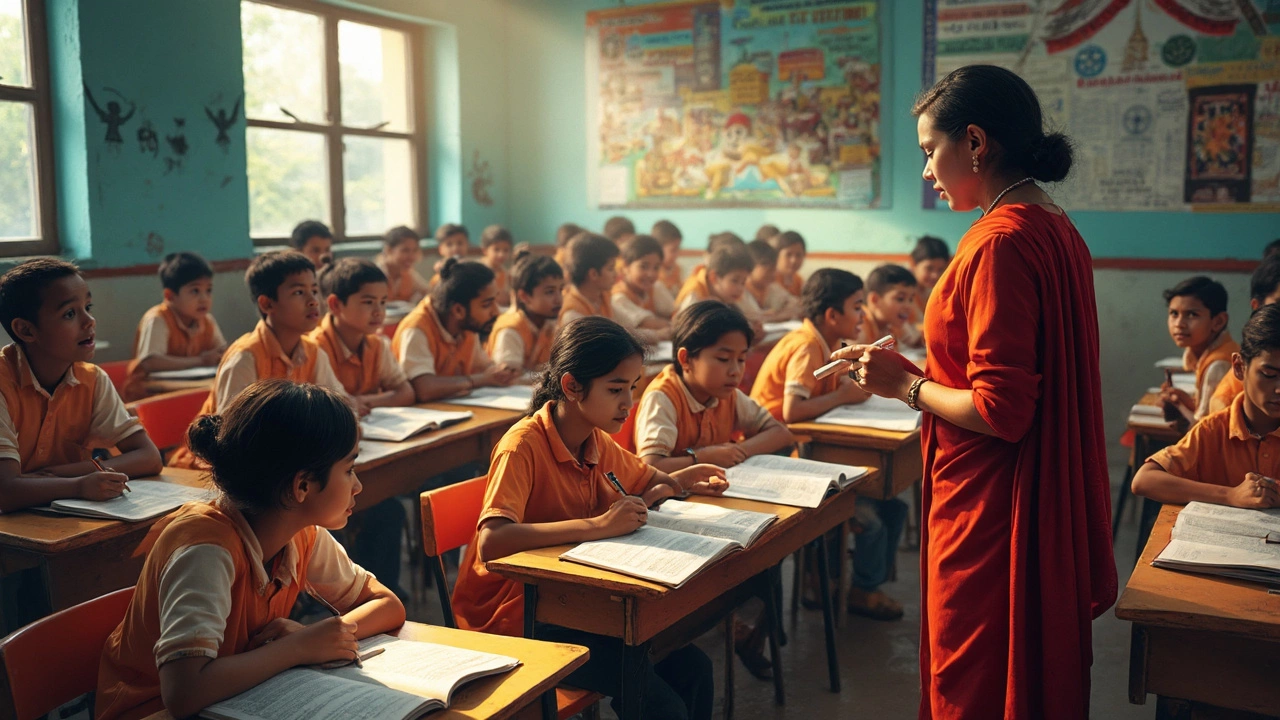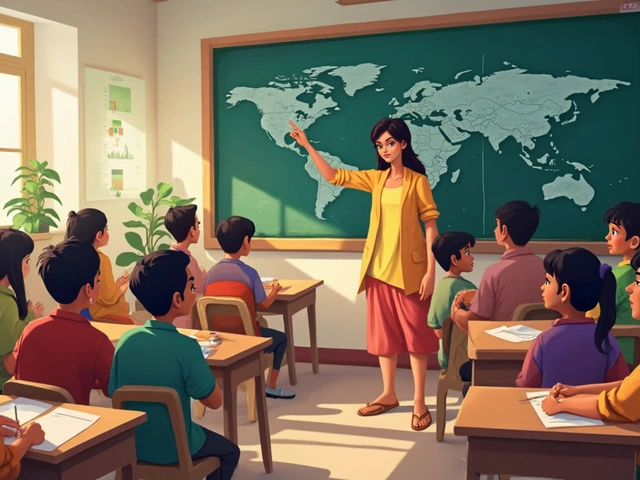Have you ever wondered which country holds the title for the toughest education system? It's a pretty hot topic among educational circles and parents alike. This isn't just about the load of textbooks; we're talking about the sheer mental gymnastics students have to perform on a daily basis.
Several countries boast education systems that push students to their limits. Whether it's the intensive hours or the sky-high expectations, these systems can put even the keenest learners to the test. India, with its CBSE board, plays a significant role in this discussion, often cited for its rigorous and comprehensive approach.
But why does this matter? Understanding what makes some education systems particularly demanding can help students, parents, and educators better prepare and adapt. And hey, it's not all doom and gloom. There are some nuggets of wisdom we can take away from these tough systems to improve educational outcomes everywhere.
- What Makes an Education System Tough?
- Ranking the Toughest Education Systems Globally
- A Closer Look at India's CBSE Syllabus
- Impact of Rigorous Systems on Students
- How Students Can Adapt and Thrive
- Global Trends: Learning from Each Other
What Makes an Education System Tough?
So, what exactly makes an education system tough? It's not just about hard tests or loads of homework. It's more about the overall approach to teaching and evaluating students. Some systems push pupils to their limits, focusing on multiple aspects that can make or break a learning experience.
Curriculum Intensity
Curriculums are at the heart of any education system, and the more packed they are, the tougher the system tends to be. For example, the CBSE syllabus in India is known for its depth and breadth, covering a wide range of subjects profoundly. This makes it necessary for students to keep up with vast amounts of information.
Examination Pressure
Tests are another cornerstone. Systems that rely heavily on exams as the primary mode of assessment often add to the stress. In these systems, students' future academic and career prospects can hinge on their performance in a single, high-stakes test.
Instruction Methods
The way subjects are taught can also determine the toughness. In some places, traditional learning is emphasized, with a strong focus on memorization rather than understanding. This method can put immense pressure on students who might not excel at rote learning.
Cultural and Social Expectations
In several countries, societal pressures play a huge role in the education system. There's a prevailing expectation for students to perform at the top level continuously. This pressure doesn't only come from schools but also from families and communities.
Here's a quick look at some numbers that highlight the daily grind students face:
| Aspect | Details |
|---|---|
| Study Hours per Week | Typically ranges between 40-50 hours in more rigorous systems |
| Number of Exams Annually | Can exceed 15 major exams, depending on the grade level |
| Student-Teacher Ratio | Often as high as 30:1, challenging personalized learning |
All these factors combined paint a picture of what makes some education systems really tough. They demand not just book smarts but also resilience and mental fortitude from students. Knowing these can help in navigating the academia jungle and coming out successful.
Ranking the Toughest Education Systems Globally
When it comes to ranking the toughest education system in the world, a few countries frequently make the top of the list. From Asia's intense academic environments to Europe's structured curricula, several nations are known for putting their students through the ultimate test of endurance and intellect.
South Korea: The Pressure Cooker
South Korea often comes to mind first. The country's focus on academic achievement is legendary. Students here face long school hours followed by after-school tutoring well into the evening, all in preparation for the College Scholastic Ability Test, a single exam that largely determines their future opportunities. It's no wonder Korean students experience immense pressure from such an early age.
Finland: Tough in a Different Way
While Finland might not have the same intense pressure as South Korea, it's considered tough because of its unique standards. Finnish schools emphasize critical thinking and problem-solving over rote learning, which can be challenging for students used to traditional memorization techniques.
India: The Rigorous CBSE
In India, the CBSE syllabus is known for its comprehensive and wide-ranging material. Students must gain proficiency in numerous subjects, often requiring a well-rounded mastery that can be quite demanding. The board exams are a significant milestone, inciting stress among students who aim to excel.
China: Hard Work and Huge Competition
Another contender is China, where students spend years preparing for the National College Entrance Exam or 'Gaokao.' This exam is notoriously difficult and determines university placement, making it a high-stakes affair. With large class sizes and a competitive atmosphere, Chinese students are pushed to excel in every aspect.
| Country | Average School Hours Per Day | Key Exam |
|---|---|---|
| South Korea | 15 hours (including tutoring) | CSAT |
| China | 12 hours | Gaokao |
| India (CBSE) | 6-8 hours | Board Exams |
| Finland | 5 hours | No standardized test pressure |
Each of these global education systems has its unique aspects and challenges, making them stand out as some of the toughest in the world. While their methods differ, these countries share a common goal of pushing students to achieve their maximum potential.
A Closer Look at India's CBSE Syllabus
When we talk about the CBSE syllabus in India, we're diving into a comprehensive learning framework crafted by the Central Board of Secondary Education. It’s widely recognized for its rigorous approach and consistency across the country.
The CBSE board focuses on a balanced mix of theoretical and practical knowledge. Subjects range from Mathematics and Science to languages and the arts, ensuring a well-rounded education. It's noteworthy that CBSE emphasizes critical thinking and problem-solving, skills that are highly valued in today's world.
The Structure of the CBSE Syllabus
One of the distinctive features of the CBSE syllabus is its structured learning pattern. This system breaks down into different levels, focusing on foundational knowledge in the earlier grades, and gradually introduces more complex concepts as students advance to higher classes.
- Primary Level: Basic language and arithmetic skills, along with introduction to environmental and social studies.
- Middle Level: Extends learning to include basic science, history, geography, and moral education.
- Secondary Level: Dive deeper into subjects like Physics, Chemistry, Biology, advanced mathematics, and optional languages.
- Senior Secondary Level: Specialization begins here, with students choosing streams—Science, Commerce, or Humanities—tailoring their studies to future career aspirations.
A table might be useful to understand the key subjects across different levels:
| Level | Main Subjects |
|---|---|
| Primary | Math, Language, Environmental Studies |
| Middle | Math, Science, Social Studies, Language |
| Secondary | Math, Science (Physics, Chemistry, Biology), Social Science |
| Senior Secondary | Stream-specific subjects like Physics, Economics, Political Science |
Challenges and Opportunities
Students often find the CBSE tough due to its vast volume and complexity, especially while preparing for board exams. However, it’s this challenge that creates opportunities. Students trained under CBSE often excel in competitive exams thanks to the solid groundwork laid by its curriculum.
Overall, while it is a demanding system, the CBSE syllabus aims to prepare students for both higher education and practical life challenges, ensuring they are competitive globally.

Impact of Rigorous Systems on Students
So, how do these toughest education systems actually affect students? Well, for starters, students under these systems face a significant amount of pressure. The intensity of daily academic life can be overwhelming, affecting both their mental and physical well-being at times. It's common for students in such environments to deal with high levels of stress and anxiety, which can sometimes lead to burnout.
Interestingly, in India, the CBSE syllabus is often talked about because of its vast and detailed content. This can be daunting. Students have to juggle multiple subjects, each with a deep and demanding curriculum, which sometimes leaves little room for extracurricular activities or personal time.
Academic Stress and Mental Health
Many experts argue that while rigorous systems aim to foster academic excellence, they can negatively impact students' mental health. Students often feel the pressure to excel constantly, leading to issues like insomnia, anxiety, and even depression. A study found that about 70% of students in high-pressure environments experience significant stress.
Building Resilience
But it's not all bad news. One bright side of these rigorous systems is that they often cultivate resilience and perseverance in students. When students navigate high expectations regularly, they tend to develop stronger problem-solving skills and a sharper work ethic. These attributes can be incredibly beneficial in the real world.
The Balance Game
Finding a balance between academic demands and personal well-being is crucial. Schools and parents need to address this by providing necessary support. Incorporating mental health awareness and stress relief strategies can make a huge difference. Encouraging students to engage in sports, arts, and social activities can help maintain this balance.
At the end of the day, it's about learning how to thrive, not just survive, in a challenging academic environment. With the right strategies and support, students can navigate these global education challenges effectively.
How Students Can Adapt and Thrive
Adapting to a tough education system might feel like climbing a steep hill, but it's definitely doable with the right strategies. First things first, embracing a structured routine can work wonders. It's about consistency, folks!
Master Time Management
Time is your best buddy here. Create a study schedule and stick to it. A lot of successful students swear by the Pomodoro Technique: study for 25 minutes, then take a 5-minute break. Repeat these cycles, and you'll be amazed at your productivity. It helps keep you fresh and focused, important especially when dealing with the demanding CBSE syllabus.
Seek Help When Needed
Struggling with a topic? Don't hesitate to seek help. Teachers, classmates, or online resources can be incredibly helpful. Joining a study group can also provide multiple perspectives on tricky topics, making them easier to grasp.
Focus on Conceptual Understanding
Instead of rote learning, try to understand the concepts. This approach will not only help in exams but also build a solid foundation for future studies. The ability to connect different ideas is what sets average students apart from high achievers.
Stress Management
Stress is normal, but managing it is crucial. Try incorporating meditation or yoga into your daily routine. A study found that students who practiced it had a noticeable drop in exam stress levels.
Utilize Resources Wisely
Make full use of the resources at hand. There are countless online platforms offering tutorials specifically aligned with the global education curricula. Choose resources that simplify complex theories and concepts.
Remember, adapting to a challenging system doesn't mean you have to sacrifice your well-being. Balance is key. With the right mindset and strategies, thriving under pressure can become second nature!
Global Trends: Learning from Each Other
In today's interconnected world, education systems are no longer confined to their national borders. Nations are borrowing successful strategies and tailoring them to fit their unique contexts. This exchange of ideas creates a melting pot of educational practices that aim to benefit students universally.
Collaborative Innovations
Finland's progressive approach, famous for minimal homework and high teacher autonomy, has been catching eyes globally. Countries like the U.S. have trialed similar methods in select districts, aiming to boost creativity and reduce student stress. Meanwhile, Singapore's structured curriculum, known for exceptional math scores, has inspired several Asian countries to tweak their own systems.
As Pauline Rose, Director of the Research for Equitable Access and Learning (REAL) Centre at the University of Cambridge, puts it:
"We need a broad-based coalition in pursuit of shared learning goals, making education more equitable and tailored to the needs of each child."This philosophy resonates as nations strive for balance between discipline and flexibility.
CBSE in the Global Mix
The CBSE syllabus itself isn't left behind. Its comprehensive and in-depth coverage of subjects, particularly science and math, is being closely observed by countries keen on enhancing their STEM fields. On the other hand, CBSE could draw insights from Finland's student-friendly methods to mitigate stress.
- Focus on core competencies
- Integrate mental well-being into standard practices
- Encourage cultural exchanges through student programs
These measures could be pivotal in creating an all-rounded approach to education.
Lessons and Stats
According to the OECD's latest report, students in collaborative education systems showed a 15% higher engagement level. These trends highlight a crucial lesson: learning from each other can significantly uplift educational experiences, no matter where you are.
Nations have a unique opportunity to craft the toughest, yet most effective education systems. Understanding and adopting global trends isn't just the way forward—it's the only way forward to ensure our students become confident, skilled, and compassionate leaders of tomorrow.



